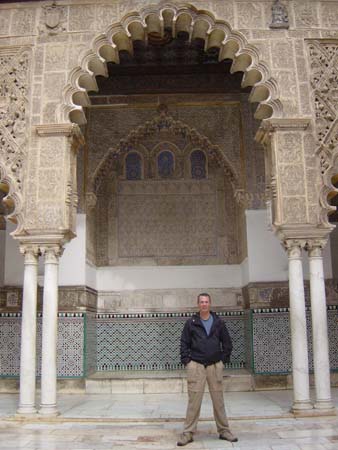Friday, October 31 (ONE WEEK LEFT!)
Steve: This morning brought cold, rain and wind - the decision to stay inside was an easy one, especially with us all fighting various ailments and in need of some additional rest. We made good use of the time, doing schoolwork and reading more about Andalucia and our remaining destinations in Spain. This worked out perfectly, because by early afternoon the skies were clear again.
 We
walked to the Alcazar, a spectacular palace with immaculate gardens. The Alcazar
was built originally as a Muslim fortress in 913 AD. Since then, it's been
used as a residence for all of Seville's rulers, resulting in a wide array
of styles. Today, the palace is still used as the official residence for the
royal family when they come to Seville. The combination of Moorish and Christian
carvings, doors, ceilings and courtyards is fascinating. Outside the palace
are huge
We
walked to the Alcazar, a spectacular palace with immaculate gardens. The Alcazar
was built originally as a Muslim fortress in 913 AD. Since then, it's been
used as a residence for all of Seville's rulers, resulting in a wide array
of styles. Today, the palace is still used as the official residence for the
royal family when they come to Seville. The combination of Moorish and Christian
carvings, doors, ceilings and courtyards is fascinating. Outside the palace
are huge  gardens
filled with fountains, fruit trees, palms and flowers - they're extremely
beautiful, and are a great place to relax. Based purely on beauty, Alcazar
ranks right at the top of all the palaces we've seen.
gardens
filled with fountains, fruit trees, palms and flowers - they're extremely
beautiful, and are a great place to relax. Based purely on beauty, Alcazar
ranks right at the top of all the palaces we've seen.
We had lunch in the Barrio de Santa Cruz, and then walked to the riverbank. This is a delightful area, and we imagine that in the warmer months it's crowded with people. There were very few people out today, and we enjoyed strolling along the river.
 We
stopped at Seville's famous bullring, the Plaza del Toros de la Real Maestranza,
to take a tour of the arena and its museum. The bullring is the oldest in
Spain, and is where bullfighting on foot began in the 18th century. The arena
is very beautiful, and we learned about several famous bullfighters who fought
here in Seville. This was also a good way to get some exposure to the art
of bullfighting, without actually going to one (the season has ended for the
year anyway). The tour took
We
stopped at Seville's famous bullring, the Plaza del Toros de la Real Maestranza,
to take a tour of the arena and its museum. The bullring is the oldest in
Spain, and is where bullfighting on foot began in the 18th century. The arena
is very beautiful, and we learned about several famous bullfighters who fought
here in Seville. This was also a good way to get some exposure to the art
of bullfighting, without actually going to one (the season has ended for the
year anyway). The tour took us through the arena, a museum, the horse stables, the chapel where the bullfighters
pray, and the infirmary that's used when "accidents" happen. The
infirmary actually looks like a small operating room, and we learned that
20% of all fights end in injuries to the bullfighter. There have been three
deaths here - two of them came in 1992. The museum houses the head of the
mother of the bull that killed a famous bullfighter - the decision was made
to kill the bull's mother so that she couldn't create any more "killer
bulls." We found this to be cruel and somewhat strange.
us through the arena, a museum, the horse stables, the chapel where the bullfighters
pray, and the infirmary that's used when "accidents" happen. The
infirmary actually looks like a small operating room, and we learned that
20% of all fights end in injuries to the bullfighter. There have been three
deaths here - two of them came in 1992. The museum houses the head of the
mother of the bull that killed a famous bullfighter - the decision was made
to kill the bull's mother so that she couldn't create any more "killer
bulls." We found this to be cruel and somewhat strange.
This evening we went to a Flamenco dance at a place called Los Gallos. Flamenco
is a very passionate combination of music, dance and song, and is Andalucia's
most defining art form. Apparently, it is now at its peak of popularity, and
there are several famous singers who have produced top- selling
albums. Los Gallos is a very small place, and we were able to enjoy this evening's
performance from very close seats. The best performer was a male dancer who
could move his feet at unbelievably high speeds.
selling
albums. Los Gallos is a very small place, and we were able to enjoy this evening's
performance from very close seats. The best performer was a male dancer who
could move his feet at unbelievably high speeds.
Tomorrow we'll rent a car and drive to Granada, where we hope to arrive by mid-afternoon.
Distance Walked: 2.85 miles
